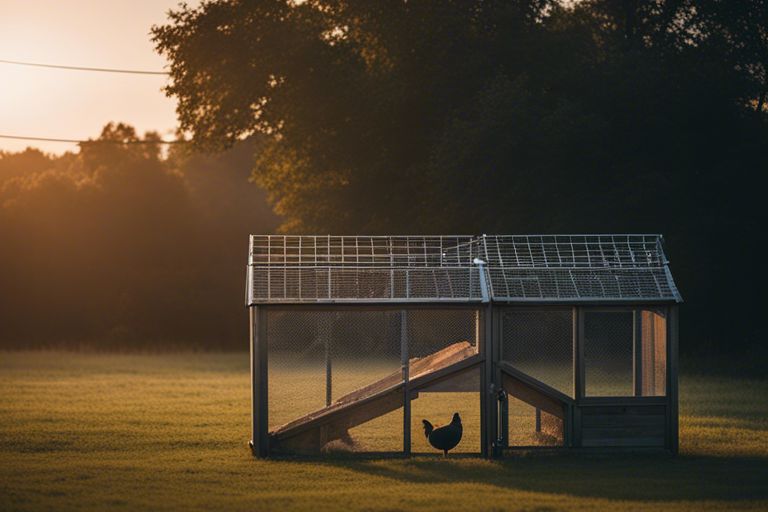Predator-Proofing Your Coop – Tips and Tricks
Tips and tricks for predator-proofing your coop are essential to ensure the safety and well-being of your flock. Protecting your chickens from predators such as foxes, raccoons, and owls is crucial for successful poultry farming. By implementing strategic measures and investing in quality materials, you can create a secure environment for your birds. In this blog post, we will provide you with expert advice on how to predator-proof your coop effectively.
Designing a Predator-Proof Coop
Materials and Construction
Any predator-proof coop starts with the right materials and construction techniques. Opt for sturdy materials like hardware cloth, which is much more secure than chicken wire. Ensure that there are no gaps or weaknesses in the structure where predators can pry or chew their way in. Reinforce vulnerable areas such as doors, windows, and vents with additional hardware cloth or heavy-duty latches.
When constructing your coop, consider the size and layout to maximize safety. Avoid using materials like plastic or wood that predators can easily break or chew through. Opt for a design that is elevated off the ground to prevent burrowing animals from digging their way in. Additionally, consider adding a secure roof to deter aerial predators like owls and hawks.
Location and Environmental Considerations
The location of your coop plays a crucial role in predator-proofing. Choose a spot that is well-lit and visible from your house to deter nocturnal predators. Avoid placing the coop near dense vegetation or structures where predators can hide. Keep the surrounding area free of clutter and debris that can attract predators.
The environment around your coop can also impact its security. Keep food sources like compost piles and garbage cans away from the coop to avoid attracting predators. Additionally, consider installing motion-sensor lights or sound devices to scare off potential threats. By carefully selecting the location and considering environmental factors, you can significantly reduce the risk of predators targeting your coop.
Coop design plays a critical role in keeping your flock safe from predators. By using durable materials, thoughtful construction techniques, choosing the right location, and considering environmental factors, you can create a predator-proof coop that will provide your chickens with a secure environment to thrive. Bear in mind, the safety of your flock should always be a top priority when designing or upgrading your coop.
Fortifying Your Coop
Assuming you want to keep your chickens safe from predators, fortifying your coop is essential. This involves using a combination of secure locking mechanisms, proper fencing, and ground barriers to create a fortress that will deter even the most determined of predators.
Secure Locking Mechanisms
An important aspect of predator-proofing your coop is to ensure that you have secure locking mechanisms in place. Predators such as raccoons, foxes, and even neighborhood dogs are adept at opening latches and doors to gain access to your flock. Invest in quality locks, such as padlocks or carabiner clips, that are sturdy and not easily manipulated by animals.
Another option is to use predator-proof latches that require multiple steps to open, making it nearly impossible for predators to figure out how to open them. Additionally, regularly check the condition of your locks and latches to ensure they are still functioning properly and have not been damaged by wear and tear.
Proper Fencing and Ground Barriers
An effective way to fortify your coop is by installing proper fencing and ground barriers. Use hardware cloth with small openings to prevent predators from squeezing through or digging into the coop. Bury the fencing at least 12 inches underground to deter digging animals like foxes and raccoons.
Consider installing an apron fence around the perimeter of the coop, extending horizontally outward to prevent digging predators from tunneling underneath. This extra barrier adds another layer of protection and makes it more challenging for predators to access your coop.
Mechanisms such as electric fencing can also be a useful addition to your predator-proofing efforts. Electric fences deliver a harmless shock to any animal that comes into contact with it, effectively deterring predators from attempting to breach the coop. Remember to follow safety guidelines when installing and maintaining electric fencing to ensure the safety of your flock and other wildlife.
Maintenance and Monitoring
Not only is it important to set up your coop with predator-proofing measures, but routine maintenance and monitoring are equally crucial to ensure the continued safety of your feathered friends.
Routine Inspections
Monitoring the condition of your coop regularly is essential in identifying any potential weak spots or damages that could compromise its security. Check for holes, gaps, or loose fittings in the structure, as predators like raccoons and foxes can exploit even the smallest openings. Inspect the locks on doors and windows to ensure they are secure and functioning properly.
Upgrades and Repairs
Upgrades and repairs should be carried out promptly to address any issues found during routine inspections. Whether it’s reinforcing the wire mesh, replacing broken panels, or upgrading to stronger locks, staying on top of maintenance will help deter predators and keep your chickens safe. Recall, it’s easier and more cost-effective to prevent breaches than to deal with the aftermath of an attack.
With regular upkeep and timely repairs, you can maintain a secure coop environment for your poultry, giving you peace of mind and ensuring their well-being in the long run.
Additional Protective Measures
Natural Deterrents and Guardians
To further enhance the security of your coop, consider incorporating natural deterrents and guardians. Predators such as foxes, raccoons, and snakes can be deterred by introducing certain plants around your coop. For example, marigolds and garlic are known to repel pests due to their strong scents. Additionally, consider attracting predators of potential threats, such as owls or hawks, to patrol the area and keep predators at bay.
Another effective method is to introduce guardian animals to your flock. Livestock guardian dogs, such as Great Pyrenees or Anatolian Shepherds, are bred to protect livestock from predators. These dogs form a strong bond with the animals they protect and will actively ward off any potential threats, providing an added layer of security for your poultry.
Technology and Alarms
With advancements in technology, there are various tools and alarms available to help safeguard your coop. Motion-activated lights or alarms can startle potential predators and deter them from approaching your coop. Some systems even include cameras that allow you to monitor your coop remotely, providing peace of mind even when you’re not physically present.
Plus, consider investing in an automatic door closer that is set to close at dusk and open at dawn. This device not only protects your flock from nocturnal predators but also ensures their safety during the night when you may not be around to secure the coop manually. By combining these technological solutions with other protective measures, you can create a robust defense system for your coop against predators.
Conclusion
Following this guide on predator-proofing your coop will help keep your chickens safe from potential threats. By implementing the tips and tricks provided, such as securing all openings, using hardware cloth, and regularly inspecting the coop for weak spots, you can create a secure environment for your feathered friends. Note, prevention is key when it comes to protecting your flock from predators, so be diligent in fortifying your coop and surrounding areas. Your efforts will pay off in the long run by ensuring the safety and well-being of your chickens.



